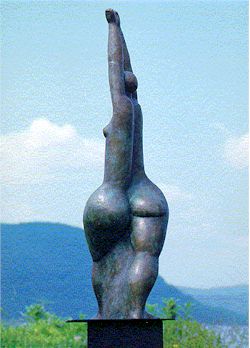Progress of the World's Women

Progress of the World's Women, an international exhibition that featured 70 artists from more than 50 countries, was shown in the visitors lobby of the United Nations in June of 2000. The exhibit opened at the start of the Special Session of the United Nations General Assembly, which reviewed progress achieved in gender equality. The exhibition presented a collective statement in bold artistic terms of the power of women at the opening of a new millennium. The exhibition - a collection of works of art across many cultures, mediums and materials - aimed to expand contemporary understanding of the world and inspire our imaginations to envision a future world where the promises of the UN Fourth World Conference on Women had been fulfilled.
The Exhibition, organized by the United Nations Development Fund for Women(UNIFEM) in partnership with the International Museum of Women (IMOW), was proudly sponsored by Volvo for Life & Chase Manhattan Bank.
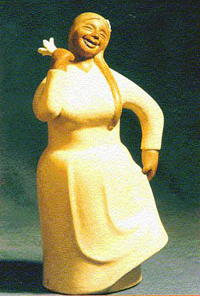
Curator's Statement, continued
All of these works of art are meant to expand our understanding of our world. That it is, in this instance, created by women for the most part — and in the last five years for the most part — allows us to interpret what we see as a collective statement in bold artistic terms about the power of women at the beginning of the 21st century. The exhibition also honors the traditional powers of women from the earliest times to the century just past. There is evidence here as well of a new conception of leadership - designed by women around the planet - in which power is shared, violence is abhorred, and friends, children, elders and our earth are nurtured.
This exhibition is meant to provoke our sensibilities, touch our emotions, and inspire our imagination to envision a world where the promises of the United Nations Fourth World Conference on Women, held in Beijing in 1995, have been fulfilled.
While the world's glaring needs stare us in the face through these artists' lens, the works of art also offer hope. Look carefully, and these artists' visions can lead us to the world of our dreams.
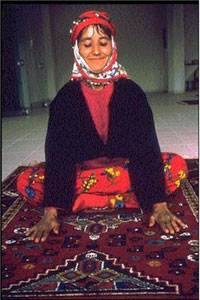
Curator's Statement
By Anne B. Zill, Curator
Progress is in the eye of the beholder. It can be positive or negative, backward or forward, small or large, linear or digital, visible or invisible, real or imagined. Progress is as infinitely conceived as are women themselves.
The United Nations Beijing +5 Review in New York, June 5-9, 2000, is an opportunity for government delegates and non-governmental organizations alike to assess progress in concrete terms, and to look for ways to come up with precise measurements of positive (or negative) achievements of women around the world during this decade.
This exhibition of women's art, Progress of the World's Women, is meant to complement our real world challenges and at the same time propel us beyond them. We can enter realms of senses, myth and imagination, feelings, dreams and desires. We can celebrate our human creativity. If "progress" suggests a journey upward and onward, these artistic statements also offer us symbolic truths about where women really are, what matters to them and what kind of future they envision.
The art exhibition, June 5 - 27, is sponsored by the United Nations Development Fund for Women (UNIFEM) and the International Museum of Women (IMOW), and represents a collection of works of art across many cultures, mediums and materials. Several of the artists have achieved international prominence, others are well known inside their own countries, and still others have not yet garnered recognition and need to be known. A few, even in this age, are still "anonymous."
Some of these works are defined as traditional, craft, avant-garde, abstract, conceptual, constructions and installations using paint, photography, cloth, metal, straw, found objects and print mechanisms.
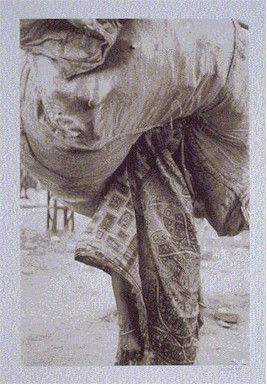
Joan Brooks Baker
photographs, USA
Baker attended the International Center for Photography, New York University, and Bennett College. This project began in India where she worked with SEWA (Self-Employed Women's Association) and with embroiderers in Bombay. She says, "A spirit and essence of the subject must be captured for the story to have tangible meaning. I believe this happens through uncharted connections. When I am available to the wonder of the story and allow the mysteries of our interaction to unfold is when I am most successful."

Paola Gianturco & Toby TuttleNdbele Beader, from In Her Hands, photographs, USA
Inspired by the United Nation Fourth World Conference on Women in Beijing, 1995, author/ photographers Paola Gianturco and Toby Tuttle traveled to twelve countries and spent five years creating In Her Hands: Craftswomen Changing the World, which will be published in October, 2000. Several photographs from the book appear in the exhibition, plus three pieces made by craftswomen they interviewed in Zimbabwe, Peru and India.
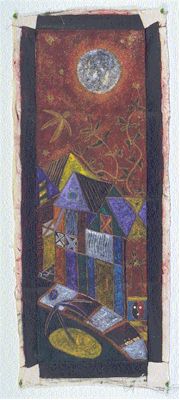
Genevieve "Iris" EspenNight Life, oil painting, HAITI
Espen was forced to give up her profession as an architect in 1992 due to the effects of the world embargo imposed on Haiti. She later developed iritis, an infection of the iris, and took up painting to relieve stress. She gave herself the artist name Iris. Of her work she says, "Our essence has no gender...just like God."
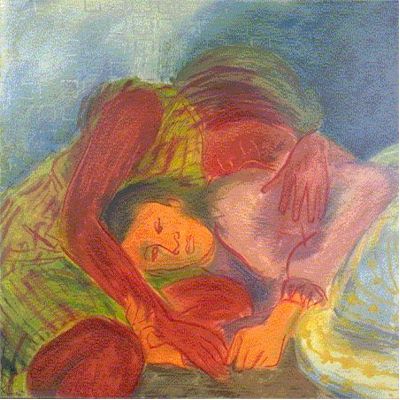
Johanne Benoit Ritual, Consolation, oil painting, USA/HAITI
"I paint women through their own experiences and portray them as they should be seen - as true role models. The different types of interaction within my Haitian family inspire my paintings, particularly those between women. They are a large yet tightly knit group of unique individuals, who display unity in adversity, community, self-respect, compassion and determination. Their sisterhood reflects...love, respect and a shared historical and cultural experience."

Doàn Thi Thu Hu'o'ng
Sapa Market, lacquer painting, VIETNAM
Hu'o'ng was educated at the Hanoi College of Industrial Fine Arts, where she studied the techniques of lacquer painting, an art form unique to Vietnam.
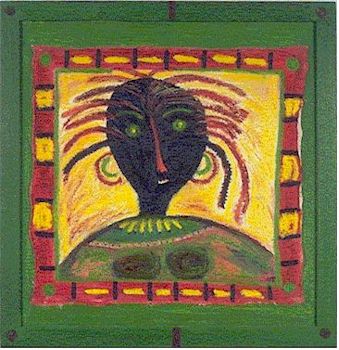
Veronique TadjoPortrait II, IVORY COAST
Tadjo is a painter and illustrator who has written three novels, a collection of poetry, and several children's books. In both writing and painting, she draws her inspiration from her African heritage. " I try to recapture traditional graphic techniques in order to bring them to life again in our contemporary situation. When I paint a portrait, I look for the essence of the person, in the same way that the traditional African carvers did not seek to reproduce reality. I endeavor to take from tradition without sinking into nostalgia. The Africa of today may be torn by conflicts and economic difficulties but it is alive and dynamic."
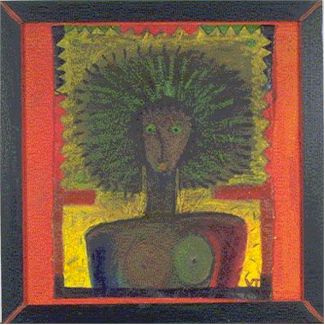
Veronique TadjoPortrait I, IVORY COAST
Tadjo is a painter and illustrator who has written three novels, a collection of poetry, and several children's books. In both writing and painting, she draws her inspiration from her African heritage. " I try to recapture traditional graphic techniques in order to bring them to life again in our contemporary situation. When I paint a portrait, I look for the essence of the person, in the same way that the traditional African carvers did not seek to reproduce reality. I endeavor to take from tradition without sinking into nostalgia. The Africa of today may be torn by conflicts and economic difficulties but it is alive and dynamic."

Genevieve "Iris" EspenThe Adorned Sun, oil painting, HAITI
Espen was forced to give up her profession as an architect in 1992 due to the effects of the world embargo imposed on Haiti. She later developed iritis, an infection of the iris, and took up painting to relieve stress. She gave herself the artist name Iris. Of her work she says, "Our essence has no gender...just like God."

AnonymousColidua, a sculpture woven of straw, BIHAR, INDIA
This is a traditional sculpture of one of the most powerful goddesses in India and the only one to be presented alone, without a man, but with many symbols of power and authority and intricate decorative elements.
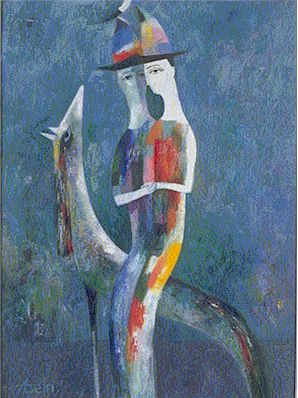
Asein JumabekovThe Dancers, oil painting, KYRGYZSTAN
Espen was forced to give up her profession as an architect in 1992 due to the effects of the world embargo imposed on Haiti. She later developed iritis, an infection of the iris, and took up painting to relieve stress. She gave herself the artist name Iris. Of her work she says, "Our essence has no gender...just like God."
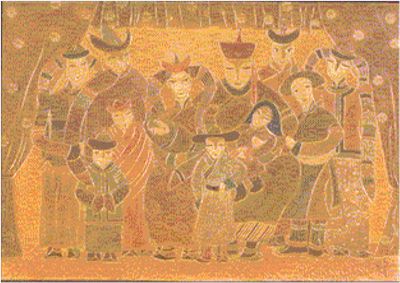
S. Enkhtumen
Family, leather wall hangings, MONGOLIA
Born in Ulan Bator, the artist graduated from the College of Fine Arts with a major in leather art decoration. She has participated in many exhibitions including Goyol-94, "Autumn," "Spring" and "Agula-II." In 1999 she participated with her 'Steppe' paint in the 'Mongolian best woman' exhibition in the Fine Art Gallery."
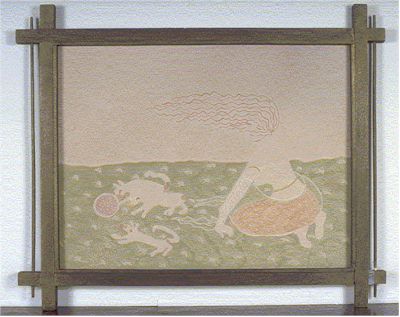
S. EnkhtumenWind for Sorrow, leather wall hangings, MONGOLIA
Born in Ulan Bator, the artist graduated from the College of Fine Arts with a major in leather art decoration. She has participated in many exhibitions including Goyol-94, "Autumn," "Spring" and "Agula-II." In 1999 she participated with her 'Steppe' paint in the 'Mongolian best woman' exhibition in the Fine Art Gallery."
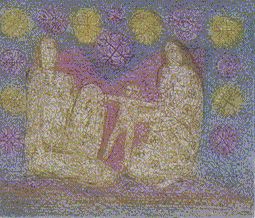
Gulnara KasmalievaTwo, color etching, KYRGYZSTAN
Kasmalieva studied at the Kyrgyz State Art School, the Academy of Fine Arts in Moscow, Russia, and the Academy of Fine Arts in Tallinn, Estonia. This work is a series of color etchings based on memories of her life. The Dream is a girl on a cow, a memory of her childhood, being stranded atop of a cow. Two is like a conversation with the inner-self, coming of age.
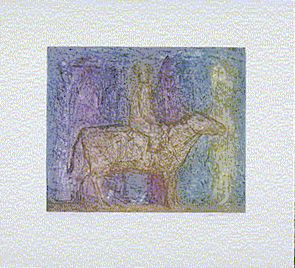
Kasmalieva studied at the Kyrgyz State Art School, the Academy of Fine Arts in Moscow, Russia, and the Academy of Fine Arts in Tallinn, Estonia. This work is a series of color etchings based on memories of her life. The Dream is a girl on a cow, a memory of her childhood, being stranded atop of a cow. Two is like a conversation with the inner-self, coming of age.

This painter, born in 1967 in Ulaanbaatar, studied at the College of Fine Arts, Ulan Bator and the Academy of Fine Arts and Theater, Minsk, Belarus. She received the Mongolian Union of Artists Award in 1995. Her piece is done in a modern style, yet these connected women suggest both traditional ties and an envisioning of the future.
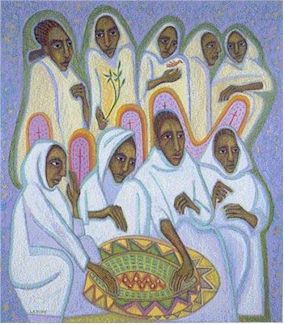
As the 1998 border war continues between Eritrea and Ethiopia, mothers and grandmothers on both sides of the border mourn the loss of their husbands, sons, and daughters in this tragic, ongoing dispute. The food they share in the Woki village during Eritrea's annual freedom celebration from Ethiopian domination is represented by cowrie shells, usually a symbol of fertility and life, now a symbol of emptiness and loss. But there is also an olive branch as grandmothers pray for peace. LaDuke, a painter, activist and former professor at Southern Oregon State University, first traveled to Africa on the Red Sea in 1993.
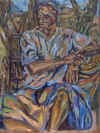
Marikasi is studying fine arts at the Harare Polytechnic University, and has participated in major exhibitions locally, including the Women's Biennale in 1999 and HIFA Visual Arts Exhibition this year. "The Labourer is a painting that relates to how women are made to work on the land while the men are in the cities. Though women work the land they are still not entitled to own it. This is why the landscape is the backdrop of this painting, as if it were detached from the labourer who works it."

These masks are part of a series entitled Breaking the Silence, a project about and for survivors of child sexual abuse. Trenshaw, herself a survivor, explores the power of art in confronting personal fears and providing a realm for transformation and healing. She says: " Masks have always been a medium for cultural expression. In our contemporary society, however, we tend to wear more subtle masks than our forebears. They tend to be ones of flesh and psyche, ones we are often not even aware we are wearing."

Growing up in Addis Ababa, Sofia Kifle was influenced by the ragged lines, warm colors, expressive eyes and the stories told by the ancient religious paintings in the churches. "I am a storyteller in color. I am mirrors and whispers. I am thoughts that are about humanity; thoughts of freedom; thoughts of pain; thoughts of struggle; thoughts of life; thoughts of humility; thoughts of fate and thoughts of strength and love."
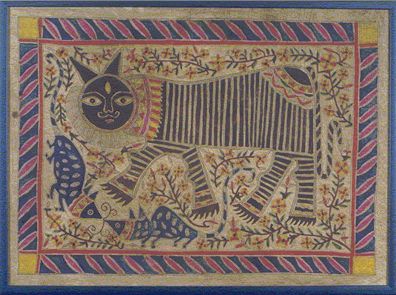
This is a traditional Madhubani decorative painting that women used to paint on the walls of their houses. Now women are painting them on paper and offering them for sale in this populous state of India.
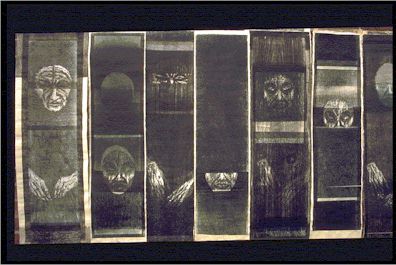
This series of unique woodblock prints evokes some of the external restraints placed on women: veiling, shuttering, foot binding, purdah. The obscuring of the facial features suggests loss of the voice and of one or another of the senses through proscribed gender limitations. A daughter of Chinese parents, Kao finds inspiration for her art in her bicultural background. "In the course of exploring my feelings about topics related to personal identity, I have also addressed the theme of the female gender role and its basis in Asian and other cultures."
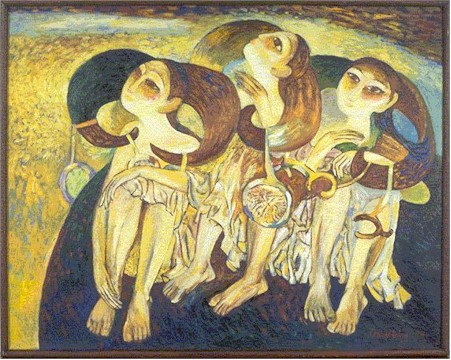
This painter, born in 1967 in Ulaanbaatar, studied at the College of Fine Arts, Ulan Bator and the Academy of Fine Arts and Theater, Minsk, Belarus. She received the Mongolian Union of Artists Award in 1995. Her piece is done in a modern style, yet these connected women suggest both traditional ties and an envisioning of the future.
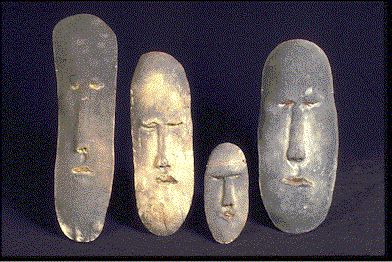
These masks are part of a series entitled Breaking the Silence, a project about and for survivors of child sexual abuse. Trenshaw, herself a survivor, explores the power of art in confronting personal fears and providing a realm for transformation and healing. She says: " Masks have always been a medium for cultural expression. In our contemporary society, however, we tend to wear more subtle masks than our forebears. They tend to be ones of flesh and psyche, ones we are often not even aware we are wearing."

The artist studied at the Lenningrad and Arts-Industrial College of Muhina in 1990, and at the Arts Academy in Bishkek in 1994. Tenderness: Either girlfriends or sisters, the headress is a reminder of a harlequin. People and animals, they feel each others feelings without words; they are silent but between them is tenderness.
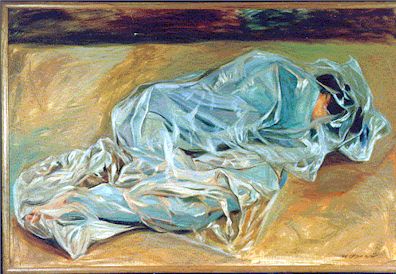
"The paintings represent the limitations of woman in relation to the veil, not the physical and tangible veil but more the mental restrictions and anxieties caused by the veil." The artist received her BA in graphic arts from the University of Art in Tehran, Iran, and has had numerous exhibitions in Iran.

Narozniak's sculpture is an abstraction of the female figure. A native of Brazil, she studied art in the United States with Robert Beverly Hale at the New York Art Students League. "Agia Talassini was inspired by the name of a ship I saw in Rio De Janeiro. Later I learned it means 'Sand of the Sea,' and is the name of the Madonna Patroness of the Greek Sailors.
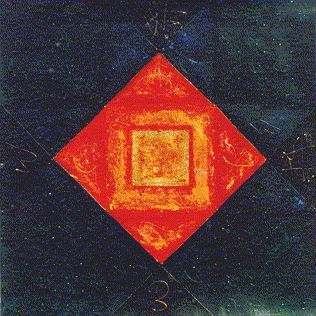
The artist studied at the Ulster College of Art and Design in Northern Ireland and at the Birmingham College of Art, UK. She has had selected solo and group exhibitions in the UK, UAE, USA, China, Egypt, Oman, France, Japan and Kuwait. "My work is based on the significance within Arab ideology of the use of talismanic motifs. The theme is talismanic protection of women, in its most simple way yet in a multi-layered and complex path. I take these from their fixed context and cultural reality reinterpreted within my own chosen space to create a valid sign system. Energy is created in the dialectic between the maker and the viewer to form a stronger talismanic language. I know how much talismans, amulets and protection mean to women here."
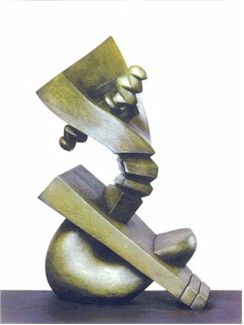
The original form of This Woman Growing Strong was inspired by a hairbrush. She is a voluminous woman who projects strength into the world, penetrating its structures. She has softness, but she is strong: she speaks, she projects. Through exaggerating certain female characteristics like swollen bellies, enlarged breasts, broad hips, powerful torsos, prominent buttocks and by exploiting a general rounded massiveness, the artist hopes to assert the power of woman.
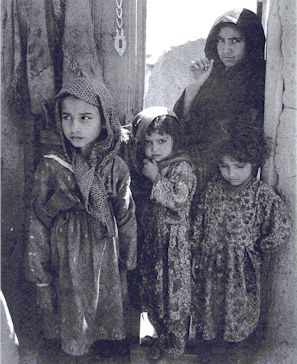
These pictures were taken during Samad's recent trip to Peshawer, Pakistan and Kabul, Afghanistan. She supervised some schools that she had been supporting in Peshawar, and assessed the educational status of women in Afghanistan. "These pictures convey the misery, sorrow, suffering, worry, sadness, anguish and fear that Afghans live with everyday of their lives."

|
ACKNOWLEDGEMENTS
|

CURATOR'S STATEMENT
By Anne B. Zill, Curator
Progress is in the eye of the beholder. It can be positive or negative, backward or forward, small or large, linear or digital, visible or invisible, real or imagined. Progress is as infinitely conceived as are women themselves.
The United Nations Beijing +5 Review in New York, June 5-9, 2000, is an opportunity for government delegates and non-governmental organizations alike to assess progress in concrete terms, and to look for ways to come up with precise measurements of positive (or negative) achievements of women around the world during this decade.
This exhibition of women's art, Progress of the World's Women, is meant to complement our real world challenges and at the same time propel us beyond them. We can enter realms of senses, myth and imagination, feelings, dreams and desires. We can celebrate our human creativity. If "progress" suggests a journey upward and onward, these artistic statements also offer us symbolic truths about where women really are, what matters to them and what kind of future they envision.
The art exhibition, June 5 - 27, is sponsored by the United Nations Development Fund for Women (UNIFEM) and the International Museum of Women (IMOW), and represents a collection of works of art across many cultures, mediums and materials. Several of the artists have achieved international prominence, others are well known inside their own countries, and still others have not yet garnered recognition and need to be known. A few, even in this age, are still "anonymous."
Some of these works are defined as traditional, craft, avant-garde, abstract, conceptual, constructions and installations using paint, photography, cloth, metal, straw, found objects and print mechanisms.
All of these works of art are meant to expand our understanding of our world. That it is, in this instance, created by women for the most part -- and in the last five years for the most part -- allows us to interpret what we see as a collective statement in bold artistic terms about the power of women at the beginning of the 21st century. The exhibition also honors the traditional powers of women from the earliest times to the century just past. There is evidence here as well of a new conception of leadership - designed by women around the planet - in which power is shared, violence is abhorred, and friends, children, elders and our earth are nurtured.
This exhibition is meant to provoke our sensibilities, touch our emotions, and inspire our imagination to envision a world where the promises of the United Nations Fourth World Conference on Women, held in Beijing in 1995, have been fulfilled.
While the world's glaring needs stare us in the face through these artists' lens, the works of art also offer hope. Look carefully, and these artists' visions can lead us to the world of our dreams.

INTERNATIONAL MUSEUM OF WOMEN
The International Museum of Women, IMOW, scheduled to open in San Francisco in 2005, will be the first world-class cultural and educational facility to celebrate and examine the roles women have played in shaping our world throughout the centuries. Through the critical exploration of women's history, contemporary issues and visions of the future, the Museum will be a catalyst for social change. The Museum will house permanent and temporary exhibitions, educational centers for children and teens, public meeting spaces, and a virtual museum accessible globally on the Internet.
IMOW P.O. Box 642370 San Francisco, CA 94164-2370
415-775-1366 · info.globalfundforwomen.org · http://exhibitions.globalfundforwomen.org

United Nations Development
Fund for Women
The United Nations Development Fund for Women, UNIFEM, with programs in more than 100 countries, provides financial support and technical assistance to innovative programs promoting women's human rights, their economic and political empowerment and gender equality. UNIFEM advocates within the UN system to link women's interests and concerns to all critical issues onthe national, regional and global agendas.
UNIFEM 304 East 45th Street New York, NY 10017
212-906-6400 ·unifem@undp.org · http://www.unifem.undp.org .

PRESIDENT’S STATEMENT
By Elizabeth L. Colton
President --IMOW
The International Museum of Women is honored to partner with UNIFEM in organizing this extraordinary international exhibition of women artists and artisans. The powerful, inspirational messages presented in Progress of the World’s Women depict both the complex realities of women's lives and the shared aspirations for justice and equality. The exhibition’s multicultural, transnational perspectives mirror the kinds of global dialogues which, today, are advancing the goal of full equality for women worldwide. This goal is a mutually held objective of UNIFEM, the Beijing Platform for Action, and the International Museum of Women.
Just as this special exhibition presents works of art that explore greater truths about female experience -- and just as this exhibition memorializes the progress of the world’s women -- the International Museum of Women will showcase the works of artists and artisans together with artifacts, media, documents, photographs, and oral histories. The sum of these parts will provide an opportunity to reflect upon the richness and diversity in women's experiences, past, present and future. Museum visitors will not only learn about the varied and too often untold stories of women's struggles, accomplishments, and daily lives, but will also encounter critical questions about gender, ethnicity, age, religion, class, culture, identity, and history itself. Knowledge of the past reinforces the promise of advancement for women and their societies at the start of a new millennium.
The International Museum of Women, scheduled to open in San Francisco in 2005, draws inspiration from UNIFEM and the historic UN World Conferences on Women. The Museum strives to become a catalyst for social change by creating an institution -- the first anywhere in the world -- to recognize, record and honor the struggles and contributions which women have made throughout history, and the history which women continue to make today. An international women's history museum would be an impossible undertaking -- indeed, unimaginable -- without the groundbreaking efforts of global women’s movements and gender studies scholarship of the last few decades. And it is no mere coincidence that the International Museum of Women will be built in San Francisco, the site of the founding of the United Nations and the first city in the United States to adopt the principles of Convention for the Elimination of Discrimination Against Women (CEDAW).
On behalf of the International Museum of Women, I wish to thank everyone who worked with great dedication and energy on Progress of the World’s Women. We are grateful for the confidence and support of Museum members around the world who helped make this exhibition possible. And, most important, we give our deepest appreciation to the incredible artists who are sharing their works and visions with us.

Executive Director's Statement
By Noeleen Heyzer, UNIFEM
The women's movement, through a series of UN conferences in the Nineties, embraced the challenge of engendering development policies and practices to transform the quality of women's lives and ultimately human life. In June 2000, women leaders and men from around the world return to the United Nations General Assembly to share insights and experiences in their quest for progress, i.e., better ways of living and interrelating to bring about gender equality, development and peace, the themes of the challenges that are being confronted and new futures envisioned. The United Nations Development Fund For Women, UNIFEM, in partnership with the International Museum of Women proudly presents an international art exhibition Progress of the World's Women in conjunction with the release of the UNIFEM report of the same title. The exhibition is a bold statement by 70 women artists from over 50 countries.
The artistic process is itself empowering and transformational. The creative process whether in art or in reshaping development requires one to step out of a self that is constructed by others, while revealing other aspects of the self that are submerged by the dominant social discourse. It allows women to assert their own understanding of themselves and the societies in which they live. Through art, activism, and rethinking development, women start a journey of becoming who they truly feel themselves to be, envisioning new possibilities and bringing them into being in the course of their everyday lives. No longer the objects of the artist's gaze, women have become the visionaries, the creators, and the agents of the kind of change they want to see in the world. Their art affirms a sense of shared identity, perceived as a process of reconstruction, invention and change, which defies the stereotype of the artist as an individual removed from society. The artists in this exhibition demonstrate how, even when placed in circumstances not of their own making, women use their agency and creativity to change their lives, individually and collectively, thereby creating their own progress. Art becomes the space of a new 'shared subjectivity,' the site of emergence for a new sense of solidarity and collective empowerment, which is a precondition for collective action and social change.
Women's art is not only about women defining their own realities - it is about women redefining art itself. Just as they challenge certain social norms and practices, women challenge conventional notions of 'art' and 'artist', conscious that art, like gender, is a socially constructed category that can be reshaped. This exhibition provides a space where women's art, in a variety of medium and in all its diversity, may be seen, experienced and reflected upon.
Progress of the World's Women, through images, ideas or practice, shows how women themselves relate to the world, not just as solitary selves, but as being in connectedness with others. Women come to understand societies and their structures because of the lives that women lead, and not in spite of them. Like women's shaping of development, women's art reflects the realities of women's lives from within the processes of living. It requires enormous amounts of courage, not only to express oneself and to make a statement about one's view of the world, but also to live in deep connection with one's creative powers and to harness those powers to recast reality and reshape our lives. This is beauty; this is progress.

FOR IMMEDIATE RELEASE
Contact: Micol Zarb, UNIFEM, 212-906-5463
Shana Penn, International Museum of Women, 415-775-1366
June 5, 2000
Progress of the World's Women
An International Exhibition of Women Artists
In Honor of the UN Beijing +5 Review
70 Artists from 50 Countries
United Nations, New York
June 5-27, 2000
New York/San Francisco -- The United Nations Development Fund for Women (UNIFEM) in partnership with the International Museum of Women (IMOW) of San Francisco is excited to announce the opening of an international art exhibition, Progress of the World’s Women to be shown in the visitors lobby of the United Nations on June 5-27. The exhibition features more than 70 artists from 50 countries including Sofia Kifle (Ethiopia), Annie Leibovitz (US), Nalini Malani (India), Egle Rakauskaite (Lithuania), Sandra Ramos (Cuba), Joyce Scott (US), and many more highly acclaimed artists. Paintings, sculpture, photography, crafts and multimedia will be on display.
“These pieces are original, brainy and have deeply insightful messages to convey,” stated Anne B. Zill, exhibition curator and director of the University of New England Art Gallery in Portland, Maine.
“We wanted examples of great women’s art, very high quality, with a relevant message,” she said. “We also sought a large representation from developing countries.” There are artists from Bosnia, Cuba, India, Italy, Kyrgyzstan, Mongolia, Peru, Spain, Vietnam, and Zimbabwe.
The exhibition demonstrates the use of a wide variety of materials and mediums and aims to expand our understanding of the world through the language of art. Some of the works are defined as traditional, avant-garde, abstract, conceptual, constructions and installations using paint, photography, cloth, metal, straw and found objects.
“Through art, activism, and rethinking development, women start a journey of becoming who they truly feel themselves to be, envisioning new possibilities and bringing them into being in the course of their everyday lives,” said Noeleen Heyzer, Executive Director of UNIFEM. “No longer the objects of the artist’s gaze, women have become the visionaries.”
“There is evidence here of a new conception of leadership designed by women around the planet,” said Elizabeth L. Colton, Board President of IMOW. “These statements offer us symbolic truths about where women really are, what matters to them, and what kind of future they envision.”
The exhibition, sponsored by Volvo for Life, opens at the start of a week-long Special Session of the UN General Assembly dedicated to reviewing and assessing the achievement of the commitments agreed upon in Bejing five years ago at the United Nations Fourth World Conference on Women.
The United Nations Development Fund for Women (UNIFEM), with programs in more than 100 countries, provides financial support and technical assistance to innovative programs promoting women’s human rights, their economic and political empowerment and gender equality.
The International Museum of Women (IMOW), a world-class cultural and educational institution scheduled to open in San Francisco in 2005, is the only museum in development that is exclusively dedicated to chronicling and honoring the lives of women throughout the world and throughout time.
An opening night reception on June 5 to celebrate the art exhibition will be hosted by Nane Annan, patron of the exhibition. She will be joined by UN Secretary General Kofi Annan, Claudia DeMonte, Agnes Gund, Lowery S. Sims, Gillian Sorensen, Noeleen Heyzer and Elizabeth L. Colton. The 5:30-7:30 p.m. reception is sponsored by Volvo for Life and Chase Manhattan Bank.
To arrange a press preview, interviews or to receive a press kit, please contact Micol Zarb at UNIFEM, 212/906-5463, or Shana Penn at the International Museum of Women, 415/775-1366.

BEIJING +5 REVIEW
The June 5th exhibition opening coincides with the start of a week-long Special Session of the UN General Assembly, “Women 2000: Gender Equality, Development, and Peace for the 21st Century.” The Special Session aims to finalize a five-year review of progress made worldwide in implementing recommendations from the Fourth UN World Conference on Women, held in Beijing in 1995.
The June 5-9 meeting will be the culmination of a preparatory process between August 1999 and February 2000, which involves UN meetings -- as well as meetings of women’s organizations and nongovernmental organizations (NGOs) -- in every region of the world to develop inputs into the global meeting. Every Member State of the United Nations will be represented at the Special Session, as will be thousands of NGOs from around the world.


